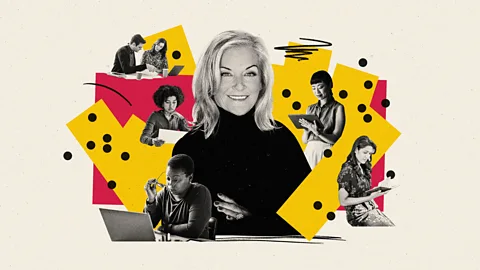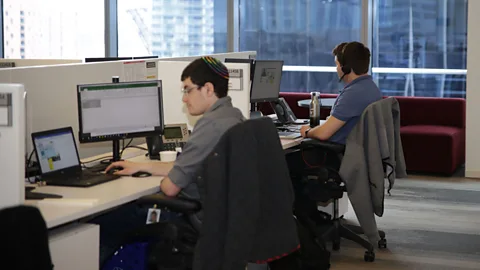How EY is focusing on neurodiverse talent – and why it benefits everyone

Karyn Twaronite, EY's global vice chair of DEI, enters the BBC's Executive Lounge to talk about how the untapped pool of neurodiverse workers can lift businesses and employees alike.
Karyn Twaronite tells the BBC that her first career step as an ant at professional-services firm Ernst & Young wasn't "sexy or exciting". Yet it's paid dividends. Throughout more than 30 years – all spent at Ernst & Young, now EY – Twaronite has climbed the ranks, rotating through different departments. When she found her way into talent and human resources, she discovered her niche.
Today, as EY's global vice chair of diversity, equity and inclusiveness, she oversees DEI programmes for 400,000 people across 150 countries. The group, says Twaronite, is around 80% Gen Z and millennial workers, average age about 27. "That keeps us on our toes innovation-wise," she says. For Twaronite, that innovation is essential, as she sees EY's work in the DEI space as a core component of business operations.
Throughout her tenure, she's taken strides to incorporate programmes for an often-underemployed group: neurodivergent workers. "We really wanted to invest in that space," she says. "It allows us for a to have an even bigger playing field of talent." Today, EY operates 23 Neurodiverse Centers of Excellence (NCoE) across the world, designed to workers with autism, dyslexia, ADHD and other cognitive differences. These neurodiverse employees – who do high-level work across AI, blockchain, data analytics and more – perform their roles in an accommodating environment with tailored professional development.
These initiatives are all part of that commitment to innovation. "I was tasked with looking at the future, and what would we need and where might we be short," she tells the BBC. "And this talent base has really been extremely beneficial for us, because all tides rise together on this population."
During Neurodiversity Celebration Week, Twaronite talks about opening opportunities for neurodiverse talent to create win-wins for both companies and their workers.
Executive Lounge
The BBC's series features interviews with executive leaders making innovative, data-driven decisions helping shape the future of business – and paving the path for other leaders to thrive. Read more conversations here.
What tangible benefits has EY seen with a robust DEI program?
We treat it like a business function, no different than how you measure and monitor and hold able and look at results. We treat DEI internally the same way we treat client services on sales and pipeline. We are very deliberate, intentional and have a methodology. We love data analytics, and I run all kinds of analytics with our experts. We have teams all over the world, and the more culturally diverse and inclusive those teams are, the better results we see.
It's not only good for business – it's also good for employees. There are very few things that are a win-win for a company and for their employees. This is one of them.
Our clients ask us about [building diverse and inclusive teams] every day – and they demand it, which I love. They don't want a homogeneous group of people trying to solve their problems. They come to us because we have many different perspectives from around the world.
You've made a significant commitment towards inclusion for neurodiverse talent. How did that start?
We built our first Center for Excellence in Philadelphia in 2016. We put out a job posting for 15 spots we reserved for neurodiverse applicants. We had people from all over the United States come to interview.
These were people with phenomenal degrees and educational experiences, but they weren't necessarily hired for the jobs that they wanted. One gentleman had a PhD from MIT, and applied for a teaching job, but he was given a janitorial staff position instead. He drove through the night from California to be able to interview for this job in Dallas.
We've since expanded our Neurodivergence Centers of Excellence across 10 countries and in 23 cities. The reality is that the focus on neurodivergent talent has been tremendously beneficial for business. Our neurodivergent employees have a 92% retention rate.
 Courtesy of EY
Courtesy of EYWhat were some of the lessons you took away from that initial class of 15?
We hired 15 amazing people. Amazing news! But EY achieved gender parity about 20 years ago, and looking at these hires, for the first time ever, I said, 'where are the women":[]}
